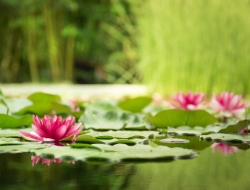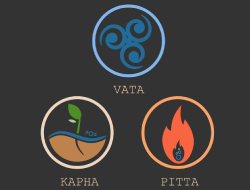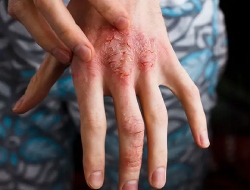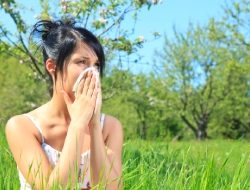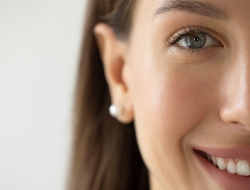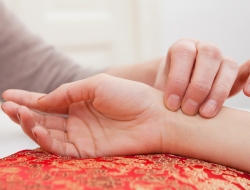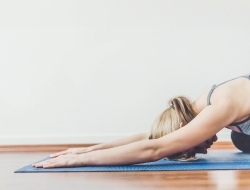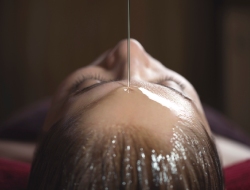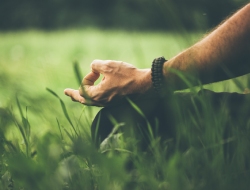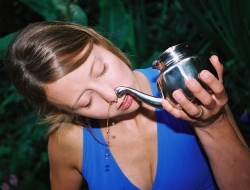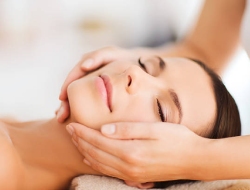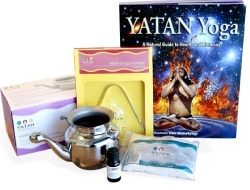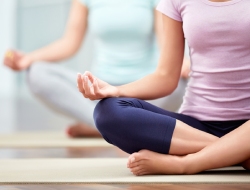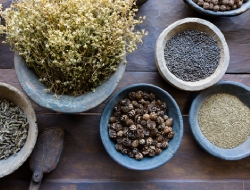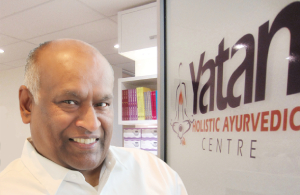Bulimia, also known as Bulimia nervosa or Anorexia nervosa, is an eating disorder characterized by episodes of binge-eating and subsequent self-induced vomiting (emesis). In other words, it is a type of eating disorder defined by overeating or uncontrolled food consumption followed by induced vomiting brought on by either feelings of stomach discomfort or guilt.
The Ayurvedic Perspective on Symptoms of Bulimia:
In today’s world of modern medicine the aim is often to gain immediate symptomatic relief. However this does not always address the root cause of the condition. Ayurveda provides an alternative option based on ancient science providing treatment for many disorders through herbal and mineral preparations.
Our Bulimia Treatment Approach:
Ayurveda works on the mind-body connection thus helping to achieve recovery from bulimia known as Bulimia nervosa or Anorexia nervosa
Read our Blog link for more information on: Bulimia (Anorexia) Nervosa Treatment
Urticaria or ‘Hives’ is an immune system reaction in which a rash of pink or red bumps come and go anywhere in the body, hives on face is also common. The problem can be long-term or short-lived and is commonly caused by a particular food or exposure to an environmental trigger, such as heat, cold or contact with a substance. Hives in children are also often seen.
What causes hives? – The Ayurvedic Perspective
Ayurveda sees this urticaria or hives as being caused by an excess of Pitta being produced by the liver or gall-bladder. This compromises the immune system, which becomes hypersensitive.
What is our Hives treatment and Urticaria treatment?
Ayurvedic treatment for hives involves pacifying Pitta, through diet and treating the liver. Yogic breathing exercises (Pranayama) are also frequently a part of the treatment program.
Blog link: Urticaria (Hives in Children): Rash, Symptoms (Causes), Treatment
The adenoids exist only in children, as small lumps of glandular tissue situated at the back of throat above the tonsils. They reach their maximum size at approximately 3 to 5 years of age and disappear completely by early adulthood. They are a part of the immune system, helping to fight infection and to protect the child against bacteria and viruses. Sometimes, due to infection or allergies they can become swollen, red and inflamed. Sore throat, throat pain and throat infections may accompany swollen adenoids.
The Ayurvedic Perspective:
Ayurveda sees the problem of adenoids as being generally due to an aggravation of Kapha, characterized by excess mucus, often accompanied by the Pitta symptoms of heat and inflammation. Excess Kapha is caused by poor digestion resulting in a build-up of waste (Ama).
Our Treatment Approach:
Following a course of Ayurvedic medicine, accompanied by an anti-Kapha ayurvedic diet, the adenoids are generally found to settle permanently.
Blog Link: Adenoids (Sore throat pain)
Acid reflux, GERD (Gastroesophageal Reflux Disorder), or ‘heartburn’ as it is often inaccurately called, are all terms used for the unpleasant burning sensation felt when some of the stomach’s contents push their way up into the oesophagus.
The Ayurvedic Perspective on causes of acid reflux:
Acid reflux is recognised by Ayurveda as being caused by excess Pitta.
Our Treatment Approach:
Ayurvedic Acid reflux treatment sets out to restore optimal digestive function but it is first essential to find out whether there is a systemic problem, such as liver function, or whether a particular deficiency needs to be addressed. Treatment addresses adrenal balance as well as lowering excess Pitta, by means of Pitta balancing herbs and a Pitta lowering diet. In general, the aim is to alkalise the body. Certain yogic practices can also be beneficial.
Read our Blog link for more information on: Acid Reflux Treatment
What Is Acne?
Acne is a common skin condition that affects most people at some time in their lives. It causes spots to develop on the skin, most commonly on the face, back or chest. The spots can range from milder blackheads and whiteheads which to inflamed pus-filled cysts, which can be severe and long lasting and can lead to scarring.
The Ayurvedic Perspective:
Acne causes are recognised in Ayurveda as a Kapha-Pitta imbalance problem. When Vata becomes imbalanced due to dietary or lifestyle factors, this aggravates Kapha and Pitta. Aggravated Pitta affects the blood and consequently the skin, causing secretion of oil from the sebaceous glands. Aggravated Kapha is excessively sweet and sticky, which causes clogging of pores and hair follicles and hence the eruption of acne. This creates a breeding ground for bacteria, and pus and inflammation ensue.
There is often a craving for sweet things, which will further imbalance Kapha, causing the situation to worsen. Hormone imbalances are frequently an issue.
Our Natural Acne Treatment Approach:
The two primary aims in the Ayurvedic acne treatment are the purification of the blood, and the acceleration of the metabolism. This is largely accomplished through a detoxification of the liver and colon, for which internal herbal formulations are provided. Hormonal acne treatment and cystic acne treatment are best achieved by detoxifying these two important organs. Additionally, pastes and powders are applied externally to open the pores and exfoliate the tissues, drawing out excess toxins and this also helps in acne scar treatment.
Read our Blog link for more information : Best Acne Treatment
What Is bloating?
Bloating after eating is the condition in which the abdomen feels uncomfortable and distended, and may even appear distended. When this is not caused by overeating it can be due to any one of a variety of digestive problems or gastrointestinal disorders which can be expressed in such symptoms as food intolerance, constipation, excess gas, or IBS.
What causes bloating?
When there is a deficiency of enzymes in the digestive system this results in insufficient digestive fire (agni). Toxins therefore accumulate in the digestive tract and eventually solidify. This causes the activity of the villi to be compromised and in time they are unable to move sufficiently to enable nutrients to reach their destination. The solidified mucus becomes a part of the gut wall.
How to reduce and stop bloating:
The gut needs to be treated first in order to restore normal digestive function. The first step is to break down the solid deposits in the gut wall. Over time the body will have tried to detoxify itself by sending waste to the liver. The liver itself will therefore be in need of detoxification. When this is achieved normal hormone production can be restored and natural enzyme production will be resumed that in turn reduces bloating stomach.
Read more with our Blog Link: Bloating Digestive System Gastrointestinal Disorders Diseases Problems
What Is breast tenderness?
Breast tenderness is experienced by most women at some time in their lives, as a result of increased hormone activity. The most common times for this to happen are during puberty, during or just before period, during pregnancy and soon after childbirth. Breast tenderness during menopause is often seen also
What causes breast pain, breast soreness or tender breasts?
Breast tenderness is recognised by Ayurveda as the result of an aggravation of Kapha.
Our Treatment Approach:
Treatment involves pacification of Kapha, with close attention to ayurvedic diet, avoiding heavy, oily foods and encouraging light, warming foods and adequate fibre. Ayurvedic medicine are selected according to the systems which require treatment, but the digestion is usually a priority to optimize the metabolism, and liver and bowel function may be addressed. In cases of stress the adrenals may also require support.
Read our Blog link for more information : Breast Pain Causes (Tenderness or Soreness) Before Period Treatment
What Is burning hands and feet?
Often women of any age, more commonly than men, can experience burning hands and feet or burning feet syndrome.
What causes burning feet and hands?
This can in either sex be due to an imbalance of pitta, which is related to the liver and which causes an uneven flow of energy in the body causing the feet and hands to feel hot while at the same time other areas of the body may feel cold. In women, however, it is most commonly due to an imbalance of the female hormones or disturbances in the menstrual cycle. Some women only experience these symptoms during menstruation and commonly have burning feet at night.
Our Treatment Approach:
To treat cases of burning hands and feet it is first necessary to find out what is causing the imbalance in the person, the liver or the hormones, and then treat accordingly.
Read More about with our Blog Link : Burning Hands and Feet
What Is Candida?
Candida is a fungus – a form of yeast – which lives in the human digestive tract. Its natural function is to aid digestion and nutrient absorption but, when the pH of the gut is allowed to become over- acidic, this can cause candida to overpopulate the system. If this is allowed to continue it can eventually break down the intestinal wall and penetrate the bloodstream, releasing toxic by-products into any part of the body and causing leaky gut. This can lead to many different health problems, ranging from digestive issues to depression which can be attributed to symptoms of candida.
The Ayurvedic Perspective:
Ayurveda sees candida as being due to an excess of Kapha, as well as involving a Pitta imbalance
What is the Ayurvedic candida treatment?
Treatment is centred on balancing the gut pH. This is achieved through attention to mineralisation and a proper candida diet in accordance with the individual constitution, for which individual advice is given, and Ayurvedic medicine are prescribed.
Read more about Candida Treatment with our Blog Link: Candida Treatment
Cellulite is a condition in which the skin acquires a lumpy, dimpled appearance. It generally affects the thighs, the buttocks, the hips or the underarm areas.
Cellulite is caused by the weakening of connective tissue near the skin surface, which allows fat to squeeze through the spaces.
The Ayurvedic Perspective on Cellulite?
Ayurveda attributes the condition to a build-up of Kapha.
What is the Ayurvedic Cellulite treatment approach?
Ayurvedic herbal pastes applied externally can help to stimulate the lymphatic flow and internal medicines are used to increase the digestive power and improve liver function. A Kapha reducing diet will be prescribed to get rid of cellulite
Read more about Celluite Treatment from our Blog Link: Cellulite Treatment
Chronic fatigue syndrome is a condition in which there is a constant state of fatigue or exhaustion that is not relieved by sleep or rest. Chronic fatigue symptoms include; low energy, lethargy, lack of motivation for exercise, work and enjoyment of life, constantly feeling tired but unable to sleep, sleeping excessively, poor appetite, feeling cold. In cases of chronic fatigue medical tests usually show that the person is well, however anaemia can often be diagnosed. The activity of the mitochondria in the cells decreases and they start to shrink causing all the peripheral muscles of the body, the muscles in the GI tract and heart muscle to decline in activity. In the long term the skin will become dehydrated and lose its tone, producing wrinkles and sagging. Nutritional deficiency is responsible for chronic fatigue syndrome; this usually affects people who are too busy to eat properly, do not eat at the correct times, do not eat the correct food which their body is asking for or skip meals. Eventually their cellular vitality will decrease and the body will take nutrients from the bone marrow to enable it to carry out its vital functions, which in turn will deplete the bone marrow. This will lead to weakening of the immune system and eventual autoimmune disorders. The reason for this is that after a long term diet which has low nutritional value the taste buds become used to the food and the brain begins to send the wrong messages to them so that eventually they are unable to distinguish between what is right and what is wrong for the body. When good quality whole foods are finally reintroduced into the diet the body is confused and does not know how to process them. This will eventually cause a collapse of the entire system leading to chronic fatigue syndrome. A compromised immune system increases the risk of infection due to parasites or viruses that a person is always exposed to in their environment or in their body: they become more susceptible to the invasion of pathogens.
The Ayurvedic Perspective on chronic fatigue syndrome:
Ayurveda perceives this condition as being due to a chronic high Vata imbalance, having the same characteristics as TB; however TB is a localised infection and due to the invasion of bacteria only, whereas chronic fatigue syndrome affects the whole body and is not a bacterial infection but the presence of viruses/parasites can be felt though these are not easily detected
What is Ayurvedic chronic fatigue treatment?
Chronic fatigue syndrome treatment involves a Ayurvedic diet rich in nourishing foods, changes to lifestyle and the prescription of Ayurvedic medicine made from herbal and mineral preparations.
Click the below Blog Link to read more information about chronic fatigue treatment :
What are circulatory disorders?
Circulatory disorders occur when blood flow to a part of the body is reduced, usually as a result of a narrowing of the arteries resulting in poor blood circulation. Typically this occurs due to the plaque or fat build-up in the artery walls, when the arteries will be deprived of micro-nutrients. Poor circulation can also affect the veins.
What are poor circulation symptoms?
Poor circulation symptoms are many and varied: cold hands and feet are very common, but some people experience excess heat in the extremities. Swelling, fatigue, slow healing infections, sluggish digestion, high blood pressure, numbness, varicose veins, brittle nails, hair loss and dry skin are just a few of the most common signs of poor circulation
The Ayurvedic Perspective of circulatory disorders?
Ayurveda sees this as a case of Kapha aggravation.
What is the Ayurvedic poor circulation treatment?
it is important to first establish in which part of the body clogging is taking place so that effective drainage can be achieved. In some cases the gut may be clogged, but in others the condition is systemic and it is then essential to detoxify the entire body. Pitta enhancing ayurvedic medicine are utilised and ayurvedic diet and healthy lifestyle advice is given.
Read more about Circulatory Problems from below Blog Links:
What causes cold feet and hands ?
Both men and women can experience cold hands and/or cold feet, for which there can be various reasons, including poor circulation, liver malfunction, hypothyroidism, and mineral deficiency, especially calcium and iron. In females, poor hormone production is a primary factor.
What is the Ayurvedic Perspective for cold hands and feet?
This is often indicative of Pitta imbalance but Vata, Pitta or Kapha types can all experience this condition, with different causative factors. Cold hands and feet are indications that there are other imbalances in the body, not only cold extremities.
What is the Ayurvedic cold hands and feet treatment approach?
Each person is treated ndividually according to his or her constitution and imbalance.
Read more about Cold Hands And Feet from our blog: Cold Hands and Feet
What is colic in babies?
Generally a new born baby has an undeveloped digestive system and is often unable to digest breast milk properly creating colic. The symptoms of colic in babies are continuous crying which leads to a red face, restlessness and inability to sleep. The baby can often be seen to pull its knees up into its chest to relieve the pain. Clenched fists are often also signs of colic.
What is the Ayurvedic Perspective on colic?
Ayurveda recognizes that there are many possible reasons for colic in babies, which may be related solely to digestion, or to a combination of emotional and digestive factors.
What is our colic treatment approach?
Colic is managed by treating the mother according to her constitution; in this way the baby will receive some of the medicine through its mother’s milk. This will enable the baby to digest the breast milk easily. The success of the medicine is shown by the baby sleeping peacefully and no longer crying. If the baby’s colic is due to formula or breast milk it can also be helped with oil massage (Abhyanga) using Ayurvedic herbal oils.
Read our Blog for more information: What is Colic in babies? Symptoms and Treatment
What is Conjunctivitis or “Pink Eye”?
Conjunctivitis is a common condition in which the thin layer of tissue that covers the front of the eye (conjunctiva) becomes red and inflamed. It can affect one or both eyes. The cause can be a bacterial (bacterial conjunctivitis) or viral infection (viral conjunctivitis), an allergic reaction (allergic conjunctivitis), or the eye coming into contact with some form of irritant.
What is the Ayurvedic Perspective on Conjunctivitis or Pink Eye causes?
Ayurveda sees recurring conjunctivitis as being due to an impaired immune system.
What is our Conjunctivitis treatment approach?
If the condition is acute it is easy to treat quickly with Ayurvedic herbal preparations, however if the patient suffers with recurring conjunctivitis it needs long term treatment with herbal preparations to strengthen the immune system. It is often necessary to address a deficiency in vitamins A, C and D, or a lack of iron.
Read more about Conjunctivitis Symptoms with our Blog Link: Bacterial Allergic Viral Conjunctivitis Symptoms of Pink Eye Treatment
Constipation is a common condition that affects people of all ages, constipation in children can be quite common. It can either mean that stools are not being passed regularly, or that the bowels cannot be emptied fully. There are many possible causes of constipation, but factors that increase the risk of constipation include not eating enough fibre, not drinking enough fluids, a change in routine or lifestyle, such as a change in eating habits, ignoring the urge to pass stools, the side effects of medication, and anxiety or depression.
What causes constipation? The Ayurvedic Perspective:
According to Ayurveda, if a person does not pass a stool at least once in 24 hours, he is constipated. In that period of time all the metabolic processes should be complete, failing which an accumulation of toxins will result, particularly in the colon. Constipation symptoms include fermentation of stool build up, excess gas, bad breath, bad skin, and bacterial, fungal and parasitic infections. The blood and lymphatic circulations suffer overload.
How to treat constipation -Our Treatment Approach:
Our constipation treatment involves a consideration of the individual body type, as this has a strong bearing on what constitutes a healthy diet. Advice is also given on eating habits, for example the ideal times to eat certain types of food, and on how different foods affect gut activity, such as peristaltic movement. The importance of adequate fibre is emphasised, as are ways of effecting a healthy lubrication of the gut wall.
Want to know about constipation relief or natural remedies for constipation?
Yes? Then call 1300 552 260 today!
Know more about Constipation Treatment with our Blog Link : Constipation Symptoms (Causes) Treatment Relief
What It Is:
The common symptoms of colds and coughs are a running or blocked nose, repeated sneezing, a sore throat, congestion of the nose and throat, headache, and sometimes a low fever.
The Ayurvedic Perspective:
According to Ayurveda coughs and colds are caused by an aggravation of Kapha. There is frequently found to be a weak digestion, which creates an excess of mucus (Ama).
Our Treatment Approach:
Treatment focuses strongly on diet, and varies greatly according to constitutional type. A Kapha type will feel cold and heavy, and will produce thick clear mucus, while a Pitta type will feel hot and dry, producing yellow phlegm and the Vata type usually has a dry, painful but non-productive cough. These differences have prime importance in understanding which foods should be avoided, As well as those that will help. An appropriate diet, together with a course of herbal medicines, generally results in quick, effective relief.
What It Is:
Both men and women can experience cramp at any time. If it is felt when exerting a muscle repeatedly and the cramp passes shortly afterwards, this is normal and no need for concern. However if a person experiences cramp in a muscle regularly and for no apparent reason then this indicates an imbalance or deficiency in the body.
The Ayurvedic Perspective:
Ayurveda sees cramp as an indicator that there is nutritional deficiency in the body. If the cramp is always localised this means that the deficiency is only in that area of the body. So even if a person is taking mineral supplements it might not be effective for localised cramp as it could be due to malabsorption in that area. In Ayurveda this is explained as being a Vata imbalance.
Our Treatment Approach:
In treating a person with cramp we first assess what is causing it and then treat according to their individual constitution and imbalance.
Read more about Cramp:
Blog Link: Leg Pain Symptoms & Treatment
What is Crohn’s Disease?
Crohn’s disease is a form of inflammatory bowel disease (IBD) that has started out as Irritable Bowel Syndrome (IBS). When an inappropriate diet for an individual has been eaten for a period of time IBS symptoms will manifest. When the cause of IBS is not dealt with inflammation starts to occur in the gastrointestinal tract (GIT) leading to IBD. If this is not addressed the inflammation will develop into ulceration of the GIT membranes, which start to bleed when the condition becomes severe and can also create ulcerative colitis. Common crohns symptoms are; abdominal pain, bloating, blood and/or mucous in the stool, diarrhoea, fatigue and weight loss.
What is the Ayurvedic Perspective?
Ayurveda sees Crohn’s disease as a disorder caused by Vata aggravating Pitta, with poor digestion, inflammation, fermentation, and stagnation of food in the cecum – a place where food tends to stagnate and ferment.
What is our crohns disease treatment approach?
The treatment plan is based on a careful assessment of the entire digestive function to ascertain which digestive enzyme levels are low and where the problem is located and if constipation or diarrhoea is also an issue. Observation of the crohns disease symptoms are carried out to help with deciding a specific treatment approach. The appropriate crohns diet advice will also be given.
Ayurvedic herbal preparations are used to:
- Increase digestive enzyme levels
- Decrease inflammation in the GIT
- Stop bleeding in the GIT
- Improve the tone and function of the GIT
- Kill any parasites and bacteria present in the GIT
- Increase immune system function
- Enhance the feeling of general well-being
This all-encompassing treatment plan will also increase blood iron and vitamin B12 and D levels.
Read our Blog for more information: Crohn’s (Inflammatory Bowel Disease): Symptoms, Treatment & Diet
What It Is:
Cystitis is inflammation of the bladder, usually caused by a bladder infection. Symptoms of cystitis include an excessive urge to urinate, pain or stinging during urination or pain in the bladder itself.
The Ayurvedic Perspective:
There is seen to be an aggravation of Pitta. The urinary tract is excessively acidic so that bacteria are able to grow more easily.
Our Treatment Approach:
Treatment is focused on balancing Pitta. This is largely achieved through a Pitta reducing diet. The gut is also detoxified by treating the colon. An increase in water intake is often advised to assist in flushing the system.
Read more about Cystitis:
Blog Link : Urinary Tract Infections (UTIs) – Causes and Cure
Depression is a form of emotional imbalance which can cause havoc if allowed to accumulate in the system. The adrenal glands can run down, hormone production goes out of control, and the brain and nervous system chemistry is affected. If depression is treated with the use of hormones, while the symptoms may seem to be temporarily alleviated there will ultimately be further imbalance which will become increasingly difficult to correct.
What is the Ayurvedic Depression Treatment?
Depression is seen in Ayurveda as a case of low Vata, in which the chakra energy all flows from the head downwards. This causes low energy in the mitochondria – the power houses of the cells and common depression symptoms will follow such as lethargy, lack of motivation, excessive sleeping, over eating, depressive thoughts etc.
What is our Treatment for Depression?
The depression treatment here involves the use of Vata-increasing herbs. Yoga is used to improve the blood circulation in the brain, hence enhancing the flow of hormones involved in neuro-transmission.
Appropriate dietary advice is essential, in keeping with specific individual requirements.
Read more about Depression with our Blog link: What is Anxiety Attack or Depression Symptoms & Treatment
What is Dermatitis?
Dermatitis is a skin disorder that can affect any person of any age. It is an inflammatory condition of the skin surface resulting in dry, flaky, red, itchy skin. These are also similar to eczema symptoms.
What is the Ayurvedic perspective on Dermatitis and Eczema?
Dermatitis is recognized in Ayurveda as stemming from a dryness of the gut wall. Due to an excess of Pitta and a reduction of Kapha insufficient mucus is being produced so that there is not enough to supply the skin.
What is our Dermatitis treatment?:
The dermatitis treatment focuses on improving the lubrication of the gut wall to increase the presence Kapha and therefore in turn pacify Pitta and lubricate the skin.
Read more about Dermatitis with our Blog Link: What is Dermatitis? Seborrheic Dermatitis & Eczema Treatment
Diabetes is a condition that causes a person’s blood sugar level to become too high. There are two types – Type 1 diabetes and Type 2 diabetes. In either type the pancreas fails to produce enough insulin to break down glucose. Blood sugar levels therefore increase, which can seriously damage the body’s organs. In the case of diabetes type 1 the immune system destroys the cells which produce the insulin so that the body produces none at all, whereas in diabetes type 2 insufficient insulin is produced. The letter type is much more common and may often be kept under control with attention to a diabetic diet. The most common diabetes symptoms and signs of diabetes are constant fatigue, excessive thirst, frequent urination and loss of muscle tissue.
What causes diabetes? The Ayurvedic Perspective:
Ayurveda sees this as a digestive problem which has developed over time. Kapha has accumulated in the pancreas, causing an overgrowth of fungi or viruses in the organ and the breakdown of cells.
Our diabetes treatment approach -:
Ayurveda has an enormous variety of medicines which it utilises in the treatment of diabetes, as there are many possible reasons for the condition. In general, the aim is to raise Pitta and lower Kapha. Appropriate dietary advice is given, and yogic exercises may be suggested to stimulate the pancreas.
Want to know about treatment for diabetes?
Yes? Then call 1300 552 260 today!
Know more about Diabetes with our Blog Link: Diabetes Symptoms (Type 1 & Type 2) Cure With Diet & Treatment
What It Is:
Diarrhoea is a digestive disturbance generally arising out of an imbalance in the production of digestive enzymes. If severe it can be accompanied by intestinal damage and bacterial or parasitic infection can often be involved. Mucosal blockages are frequently present in the intestines.
The Ayurvedic Perspective:
Where there is an imbalance of Vata there can be an explosive shiny stool, while a Kapha imbalance leads to excess mucus, and an imbalance of Pitta to a bloody, burning stool.
Our Treatment Approach:
Ayurvedic herbal medicines are utilised to stimulate a healthy level of enzyme production. Other herbal medicines also bind with the food to assist in healthy elimination. Dietary advice is a very important aspect of the treatment as diarrhoea can frequently be a reaction to specific foods: lactose intolerance is a typical example.
Read more about Diarrhoea:
Blog Links:
What are Dry Eyes Causes?
Dry eyes (or Dry eye) are caused by the dryness of the lachrymal gland. Dry eye symptoms include ‘gritty’ eyes, redness, itching, dryness and feeling uncomfortable throughout the day. Dry eyes are often treated medically with eye drops or lubricant but these usually only provide temporary relief and become a necessity for the person to be relieved of the symptoms of dry eyes.
What is the Ayurvedic Perspective on Dry Eyes?
According to Ayurveda this is due to a Vata aggravation in the eyes. This creates dryness due to lack of lubrication and then dry eyes symptoms will start to be exhibited.
What is the Ayurvedic Dry Eye Treatment?
Ayurveda has a dry eyes treatment called Netra Basti which uses warm sesame oil to bathe the eyes. This can often give immediate relief but in order to find a permanent solution we will always investigate the underlying cause. One example of a possible causative factor is a hormone imbalance this is common in both men and women.
Know more about Dry Eyes with our Blog Link: Dry Eye Syndrome: Symptoms, Causes and Treatment
What It Is:
Dry skin is a very common problem amongst both men and women. according to the country. In Europe it is mainly due to excessive cold weather during the winter, whereas in Australia it is because the country is located in the southern hemisphere and therefore the intensity of the sun’s rays is higher due to the lack of ozone layer. Dry skin is very prevalent in Australia regardless of constitution and state of health; it can be purely due to the climate. In Asia the climate is less responsible for dry skin, the condition is usually due to an imbalance in the person’s system.
The Ayurvedic Perspective:
Dry skin is explained in Ayurveda as being the trapping of excess air in the skin – i.e. aggravation of Vata.
Our Treatment Approach:
Treatment involves reducing Vata and increasing Kapha in the skin. In certain cases the dryness is found to be due to dehydration of the kidneys or to a diet high in protein, e.g. a macrobiotic diet. Vitamins C, D and E may be prescribed as these are often very effective in the management of dry skin.
Blog Link: Could your Low Energy and Weight Problems indicate Hypothyroidism?
Wrinkles Dry Skin Problems on Face: Anti-Aging Facial Skin Rejuvenation
What is an Ear Infection?
Ear infections can be fungal or bacterial. There is often a drying up of mucus, and an acid – alkali imbalance is likely. Both middle ear infections and inner ear infections are possible often causing a lot of ear pain. Glue ear is where there is chronic blocked ear.
What is the Ayurvedic perspective on Ear problems?
Earache or ear pain is frequently seen as a problem of excess Vata. Excess air from the colon builds up in the ear. Glue ear is related to an excess of Kapha.
What is our approach for ear infection treatment?
Ayurvedic ear infection treatment involves careful attention to diet, as many foods aggravate the situation. Purifying and anti-fungal herbs are taken both internally as well as drops.
Read more info with our Blog link: Blocked Ear Pain | Middle or Inner Ear Infection Treatment
What is Eczema?
Eczema is an inflammatory condition of the upper layers of the skin. There are various types of eczema; some dry, some watery, and these can vary greatly with climate giving varying eczema symptoms.
In all cases, Ayurveda sees eczema as the result of a Pitta imbalance. Typically, the body can be excessively hot while the pulse may be cold. Certain foods, particularly citrus and spicy, can act as eczema causes.
What is our Eczema treatment?
Effective eczema treatment involves correction of this imbalance through a specific eczema diet, through the use of herbs that boost the production of healthy mucosal lubrication, through attention to the liver, and by the use of creams and herbs for the topical treatment of the skin. These all provide excellent natural remedies for eczema.
The eczema treatment will typically be maintained for at least 4-5 months, but good results generally begin to be experienced within the first three months.
Read more about Eczema Treatment with our Blog Link:
What is Emphysema?
Emphysema is one of a number of chronic obstructive pulmonary diseases (COPDs). The main emphysema symptoms are difficulty breathing, breathlessness when active, persistent coughs with phlegm and chest infections.
What are the causes of Emphysema from the Ayurvedic Perspective?
Emphysema causes are seen as a Vata/Kapha disorder which builds up over time. Stresses which affect the lung cells over a long period cause Kapha to accumulate, the classic cause of this is smoking. The spaces within the lung cells increase and more mucus is produced to fill the spaces, causing clogging.
What is our Emphysema treatment approach?
Treatment primarily involves the use of anti-Kapha medicines and a Kapha reducing diet. Herbal medicines are also employed to rejuvenate the lung cells. As this condition has taken a long time to develop the emphysema treatment also takes considerable time.
Want to know more about emphysema and how to treat it?
Call 1300 552 260 today!
Read our Blog Link for more info : Emphysema Symptoms Causes Treatment
What It Is:
Endometriosis is a common condition in which small pieces of the womb lining (the endometrium) are found outside the womb. This could be in the fallopian tubes, ovaries, bladder, bowel, vagina or rectum.
Endometriosis is a long-term (chronic) condition that can cause painful or heavy periods. It often causes pain in the lower abdomen, pelvis or lower back. It may also lead to lack of energy, depression and fertility symptoms, while some women have few symptoms or no symptoms at all.
The Ayurvedic Perspective:
There is an imbalance of hormones or Kapha starts to accumulate in the pelvic organs.
Our Treatment Approach:
This is commonly a metabolic disorder and treatment is focused on reducing Kapha. An anti-Kapha diet and exercises are prescribed.
What It Is:
Epilepsy is a condition that affects the brain, causing repeated seizures. The neurons in the brain use electrical impulses to communicate with one another, and during a seizure these impulses are disrupted. The effect can be compared to a fuse blowing – a survival mechanism to prevent further damage.
The Ayurvedic Perspective:
Ayurveda explains epilepsy as being due to an excess of Vata invading the brain.
Our Treatment Approach:
Ayurvedic treatment focuses on calming Vata. Many herbs have proved effective in this respect, though the effect of different herbs varies from person to person. Sometimes herbs used for head massage can also help greatly. Research has found meditation to be highly beneficial.
Blog link: Ayurvedic Treatment for Epilepsy
What Is A Fibroids?
Fibroids are non-cancerous tumours that grow in or around the womb (uterine fibroids). The growths consist of fibrous tissue and vary in size. Many women who have fibroids in the uterus are unaware of them as they experience no symptoms. When fibroids symptoms are present the most common are abdominal or lower back pain, constipation, painful sex and frequent urination. They may also lead to infertility or complications with pregnancy.
The Ayurvedic Perspective:
According to Ayurveda fibroids are symptomatic of excess Kapha caused by a hormone imbalance, creating a build-up of mucus in that area.
Our Fibroids Treatment Approach:
Fibroids Treatment involves rebalancing of hormones and reduction of Kapha. The methods used will vary according to age.
Follow our Blog Link to read more about uterine fibroids symptoms : Uterine Fibroids in the Uterus: Symptoms, Causes & Treatment
What is Fibromyalgia?
Fibromyalgia is a long-term condition which causes pain all over the body. Other fibromyalgia symptoms include extreme fatigue, muscle stiffness, IBS, headaches and insomnia.
What is the Ayurvedic Perspective on Fibromyalgia Causes?
According to Ayurveda fibromyalgia is due to an excess of Vata that has caused the Kapha to become depleted with the result that the microfibres contract and the skin cannot obtain sufficient nutrients.
What is our Fibromyalgia Treatment Approach?
Our treatment for fibromyalgia utilizes both internal and external medicines, in particular preparations which will stimulate the circulation. The medicines used are often the same as those used for arthritis. A fibromyalgia diet will also be advised where appropriate.
Read more info with our blog link : Fibromyalgia Syndrome Symptoms (Causes) Pain Treatment
What It Is:
This is a build-up of fluid in the body which causes affected tissue to become swollen. Oedema can occur anywhere in the body but most often affects the feet and ankles. It may simply be caused by Long periods of immobility or by very hot weather, but it is also very common in women before their period, in pregnancy, and also during the menopause. In other cases it is frequently a symptom of an underlying health condition, for example kidney, lung, thyroid or liver disease, heart problems, lymphatic blockage or hormone imbalance.
The Ayurvedic Perspective:
According to Ayurveda fluid retention is one of the primary symptoms of excess Kapha.
Our Treatment Approach:
Because of the great variety of underlying causes treatment needs to be highly individualised, but in most cases A Kapha-reducing diet will be prescribed.
Blog Link: Lymphatic Drainage Massage
What Is Gingivitis?
Gingivitis is described as a form of gum disease with the following gingivitis symptoms; inflammation, redness, swelling, bleeding and itching of the gums. Although bacteria are the cause of this condition, which are linked to poor oral hygiene, it is related to the digestive system, gut flora imbalance, metabolism and acidity of the body.
The Ayurvedic Perspective on Gingivitis Treatment :
Ayurveda recognises this as a Pitta and Vata aggravation in the area of the gums.
Our Gingivitis Treatment Approach:
This gingivitis treatment plan is long term and so proper dental and oral hygiene is also required. This involves brushing the teeth after every meal, rinsing the mouth with an Ayurvedic herbal mouthwash, using dental floss and massaging the gums with Ayurvedic gum oil. Herbal preparations are used to create a more alkaline pH environment in the digestive system, improve the gut flora and levels of trace minerals in the body.
Blog Link: Gingivitis Symptoms & Treatment
What are Hemorrhoids or Piles?
Hemorrhoids are swellings in or around the lower rectum or anus, containing enlarged blood vessels.
What causes Haemorrhoids? – The Ayurvedic Perspective
Piles are due to long-term constipation. From the Ayurvedic perspective piles are due to one of two things: either muscular growth around the anus, which is very painful especially during evacuation, this type being due to an aggravation of Vata, or by Pitta aggravation.
What is our Hemorrhoids Treatment Approach?
Hemorrhoids or piles treatment in Ayurveda are done with either Vata or Pitta balancing herbs and diet. In the case of piles due to aggravated Vata a diet high in foods that cause constipation should not be eaten. Treatment involves a long-term course of herbal medicine, which should be taken even after the hemorrhoids have cleared so as to act as a preventive measure.
Read more info with our Blog link: Hemorrhoids (Piles) Symptoms Treatment
What It Is:
Rhinitis is inflammation of the lining of the nose caused by an allergen, such as pollen, dust, mould or certain animal danders. Allergic rhinitis often causes cold-like symptoms, such as sneezing, and a blocked or runny nose. These symptoms usually start soon after being exposed to an allergen. Some people only suffer from the problem for a few months at a time because they are sensitive to seasonal allergens, such as tree or grass pollen; this is generally referred to as hayfever. Other people suffer from allergic rhinitis all year round. In all cases it is an immune system problem.
The Ayurvedic Perspective:
Excess air can dry out Kapha, causing irritation. Vata aggravation is also indicated as Vata governs the responses of the immune system.
Our Treatment Approach:
The Ayurvedic approach to treatment looks at a number of issues:
- Cleansing & lubrication of the nasal mucus membrane
- Modifying the reactions of the immune system through herbs
- Dietary advice – some foods irritate
- Exercise – Yoga can be of great assistance in balancing the body systems
This multi-faceted approach can often eliminate the problem in one year.
Read more about Hay Fever:
What is a Headache and what causes Headaches?
Headache causes can be due to many things including: intensity of UV rays, over-exposure to electromagnetic radiation, food intolerance, adverse reactions to medicine, stress, hormone imbalance, insomnia, busy lifestyle, moon cycles, individual capacity to absorb sun energy, postural problems, imbalance of the brain hormones, constipation, food poisoning, heightened sensitivity, blood pressure and respiratory congestion. Tension headaches and sinus headaches are also very common causes of headaches.
What is the Ayurvedic Perspective on headaches?
From an Ayurvedic perspective headaches are also seen to be due to dosha imbalances, for example: menopause, insomnia and stress induced headaches are caused by Vata imbalance. Pitta imbalanced headaches can be caused by fever, migraine, sunstroke, etc. and Kapha imbalanced headaches may be due to respiratory congestion, cough, cold and asthma.
What is our Headache Treatment Approach?
Each person is treated individually according to their doshic imbalance; this is the opposite to conventional medicine which treats all kinds of headache relief with the same medicine, e.g. paracetamol.
Read more information with our Blog Link: Low Testosterone Symptoms (Low libido in women) Treatment
What It Is:
The herpes virus can affect either the mouth or genitals. In either case it is very virulent and when not in its active state will stay dormant within the body, often for life.
The Ayurvedic Perspective:
Ayurveda sees doshic imbalance as being the cause of viral disorders of this type.When a person’s pitta is too high and they are under stress the pH balance in their body can become disturbed creating an acidic environment that produces toxins that feed the virus and further its spread.
Our Treatment Approach:
Ayurvedic medicines are prescribed. These have what is called ‘bio-sense’, meaning that they are able to work on many levels within the body providing the appropriate treatment and reaching the areas where it is needed. As the immune function improves and the doshas balance from taking the Ayurvedic medicines it is important to continue with them so as to provide reserves in the body’s systems and strengthen it reducing the chance of future herpes outbreaks.
Read more about Herpes:
Blog Link: Shingles Symptoms (Causes) Treatment
What It Is:
Hypertension is diagnosed if a person’s blood pressure reads consistently at a level of 140/90 or higher.
Consistently high blood pressure has no symptoms but puts a strain on the heart and arteries as well as the brain and kidneys and it increases the risk of heart attack or stroke.
The Ayurvedic Perspective:
Ayurveda sees hypertension has an imbalance in all the doshas, but primarily as an aggravation of the Vata and Pitta doshas.
Our Treatment Approach:
Ayurveda’s approach to the treatment of high blood pressure is multi-faceted and individual dietary considerations are of prime importance. Frequently it is found that high blood pressure sufferers are pursuing a diet high in meats but low in vegetables. Personalised dietary advice is given based on your body type (dosha). Further advice based on your individual constitution involves changes in lifestyle. Some simple, but effective tips may be given, for example drinking more water in the mornings. This has the additional benefit of being good for the kidneys. A personalised exercise regime to improve flexibility is also very important, in particular exercises involving bending. A 20 minute daily yoga regime, involving movements that utilise different angles, is the most effective form of exercise to address flexibility. Meditation is yet another Ayurvedic tool that can be surprisingly effective in lowering blood pressure.
Read more:
Blog Link: Ayurveda and the Long Term Consequences of High Blood Pressure
What It Is:
Attention deficit hyperactivity disorder (ADHD) is a group of behavioural symptoms which include hyperactivity and inattentiveness. Attention deficit disorder (ADD) is a subtype of ADHD. Common symptoms include restlessness and a short attention span. This can occur in people of any intellectual group, but many also have additional problems such as learning difficulties and sleep disorders.
The Ayurvedic Perspective:
Ayurveda sees the problem as being indicative of aggravation of Vata. When excess Vata invades the brain the mind cannot focus and anxiety often follows. Stress causes an excess of adrenaline to be produced and the adrenal glands eventually become exhausted. The immune system is then greatly weakened, energy levels decline and the circulation becomes inadequate.
Our Treatment Approach:
The Ayurvedic treatment makes extensive use of herbs to calm the adrenals and to balance the brain hormones. Brahmi, Shankhapushpi and Jatamansi are a few of the most common.
Blog Link: Ayurvedic Treatment for the Distressed Child
What It Is:
IBS is a common disorder of the digestive tract. It symptoms can include diarrhoea or constipation, stomach cramps and bloating, feeling constantly hungry or having no appetite at all, general weakness, low libido, constant tiredness and anaemia.
The Ayurvedic Perspective:
According to Ayurvedic principles, IBS is due to a long-term diet and lifestyle that is incorrect for the person’s constitutional type.
Our Treatment Approach:
IBS is treated with herbal medicine that stimulates the secretion of enzymes and the action of villi in the digestive system. The medicine also increases and improves the gut flora. However each person is treated individually as not everyone responds in the same way to each medicine.
Read more about IBS:
What is the Immune System?
The immune system has the function of seeking out and destroying disease-causing organisms or substances. While a weak immune system makes us susceptible to virtually any disease it is also possible when the system is out of balance for the immune response to become overactive or misdirected. This can lead to a variety of disorders, including autoimmune disease and allergies.
What is the Ayurvedic Perspective on Immune System Disorders?
The Ayurvedic view is that when there is an excess of Vata air is trapped in the nervous system, suffocating the cells, this in turn causes a reduction of Pitta, resulting in a slowing down of the metabolic processes. Waste accumulates and the transport systems are compromised, so that the cells are deprived of their nutrients. When the supply to the bone marrow is depleted this affects the immune system.
What is our treatment approach for autoimmune disorders, autoimmune diseases and immune system diseases?
Ayurvedic treatment seeks to restore balance by optimising the digestion and removing the toxic waste which is causing the system to clog. Put simply, the Ayurvedic treatment of immune system imbalances depends upon strengthening the system rather than suppressing its responses, and the medicines which are used for this purpose are often exactly the same as those given to boost vitality.
Read our Blog Link for more info: Autoimmune Disease | Low Immune System Disorders | Immune Deficiency
Autoimmune Diseases Disorders | Immune Deficiency System Disorders Diseases
What It Is:
Incontinence is the term used for the unintentional passing of urine. In the great majority of cases it is caused by weakness of the bladder and pelvic floor muscles, or in the case of stress incontinence, by overactivity of those muscles. Many women experience incontinence due to muscular weakness.
The Ayurvedic Perspective:
According to Ayurvedic principles, aggravation of Pitta is generally involved.
Our Treatment Approach:
In Ayurveda this is treated with herbal preparations and certain yoga postures; however, the herbal preparations alone are very effective. The muscle weakness can often be due to a localised deficiency of calcium, magnesium and other trace minerals and replacing these can give quick results.
Read more:
Blog Link: Ayurvedic Treatment for Female Incontinence
What is Infertility?
Infertility is the inability of a couple to conceive. There are many possible causes but fertility problems can affect either the man or the woman. Female infertility seems to be most commonly talked about however.
What is the Ayurvedic Perspective on getting pregnant?
According to Ayurveda, conception is dependent on healthy sperm, ovum and uterus. For both men and women, reproductive health depends on the health of the shukra dhatu, or reproductive tissue. The shukra tissue creates the healthy reproductive tissue depends on the health of all the other tissues in the body.
What is our approach to Infertility Treatment?
Ayurveda addresses every aspect of a patient’s health, not just the reproductive system. Diet and digestion are of the utmost importance in preparing to conceive. The human egg can only survive if there is a good acid-alkaline balance, so if the system is too acidic a preliminary detoxification will be called for therefore addressing one of the major causes of infertility. Attention is given to the purification of the blood and to the circulation in general, to ensure an adequate blood supply to the uterus. The digestive function is optimised by cleansing the digestive system. Careful attention is given to diet. Ayurveda also has many herbal medicines to detoxify and nourish the reproductive organs, thereby restoring natural rhythm and improving fertility. Circadian rhythms are also taken into account; there is a need for daily routines, in particular regular bedtimes and mealtimes. After ovulation and before menstruation daily Yoga practices can help to enhance the circulation.
A similar regime applies when the male is being treated for infertility. Here there is a strong focus on medicines which treat the bone marrow, as this is essential for the production of healthy sperm.
Read more information with our Blog Links:
What It Is:
Insomnia is difficulty getting to sleep or the inability to stay asleep for long enough to feel refreshed the next morning.
The Ayurvedic Perspective:
Insomnia is seen as being caused by a doshic imbalance. It is possible for any of the three doshas – Vata, Pitta or Kapha – to be involved.
Our Treatment Approach:
A treatment plan has to be made to cater for the individual, as no two people are the same with regard to doshic imbalances. It is very likely that attention will need to be given to adrenal function. In all cases a daily routine has to be established to manage individual symptoms. This includes dietary advice on when and what to eat, and biorhythmic balance and circadian rhythms require to be restored. This is best achieved through yoga exercises. Herbal medicines are prescribed to balance the hormones.
Blog Links:
What Is Jaundice?
Jaundice is the term given to the yellowing of the skin and the whites of the eyes (yellow jaundice). It is a symptom of a liver disorder. It is common to find jaundice in adults, jaundice in babies and jaundice in newborns.
What causes Jaundice? The Ayurvedic Perspective:
Jaundice causes are poor diet that leads to an aggravation of Pitta, impairing the blood and causing blockages in the liver. Pitta in the form of bile returns into the blood, leading to discolouration.
Our Jaundice Treatment Approach:
Jaundice treatment involves pacifying aggravated Pitta using herbs that stimulate the liver function and improve bile flow. Proper digestion and metabolic function is restored by means of a customized diet plan.
Read more about Jaundice with Blog Link: Jaundice in Babies (Newborns) Adults Symptoms: Treatment
What is Laryngitis?
Laryngitis is a temporary inflammation of the larynx, causing laryngitis symptoms of hoarseness, difficulty speaking and often a sore throat.
What is the Ayurvedic Perspective on the causes of laryngitis?
According to Ayurveda the condition is usually caused by an accumulation of Kapha but where the airways are dry or obstructed there may be Vata aggravation or in the case of excess Pitta acute inflammation is likely.
What is our Laryngitis treatment approach?
In order to treat laryngitis effectively we must first understand the underlying imbalance, as there is a difference between acute and chronic forms and it is necessary to know whether we are treating a viral, bacterial or fungal condition. The lungs, also, may need to be taken into consideration. A combination of topical and internal treatments is utilised.
Read more about Laryngitis with our Blog Link: Laryngitis How To Get Rid Of A Sore Throat Causes Treatment Remedies
What is Loss of Appetite?
A decreased desire to eat or lack of appetite is often only a temporary issue, but if it continues this could be indicative of underlying physical or mental condition often seen in anorexia.
What is the Ayurvedic perspective on loss of appetite causes?
Excess Kapha causes a loss of appetite and the body becomes generally heavy and lethargic. Enzyme activity and liver function become sluggish. Excess Vata can cause similar problems, often accompanied by weight loss and exhaustion. There is frequently excess acidity in the system.
What is our Treatment Approach for loss of appetite?
Ayurvedic treatment for anorexia or lack of appetite will involve individualised dietary advice and also the best times to eat, according to individual biorhythms. Herbal tonics are an important part of the treatment.
Read more about Loss of Appetite with our Blog Link: Anorexia Symptoms (Lack) Loss Of Appetite Causes Treatment
What It Is:
Low libido is a loss of interest in sex. It is a very common problem, much more so in women than men, and is often a temporary issue. When it is permanent it is likely to indicate an underlying physical or emotional problem.
The Ayurvedic Perspective:
According to Ayurveda, when the doshas are out of balance this results in a hormonal imbalance. Libido low testosterone is seen to be related to vitality, and when the supply of hormones is depleteted lowered vitality results.
Our Treatment Approach:
Ayurvedic low testosterone treatment involves first establishing which organ or system is at the root of the problem and Ayurvedic medicines are selected accordingly. It is however recognised that in most cases Pitta is at a low level and emphasis is therefore placed on increasing Pitta. A Pitta enhancing diet is therefore prescribed. The treatment can be greatly enhanced by the use of certain yogic exercises and postures.
Read our Blog link for more information on: Low Libido in Women
Low Testosterone Symptoms (Low libido in women) Treatment
What It Is:
Male erctile dysfunction (Impotence) is the inability to achieve or sustain an erection in such a way as to make normal sexual intercourse possible. It can have medical or psychological causes and is estimated to affect as many as 50% of men between 40-70. It is commonly seen as being part of the aging process.
The Ayurvedic Perspective:
Whether it has a physical or a mental cause Ayurveda sees this disorder as being due to a doshic imbalance.
Our Treatment Approach:
In view of the wide variety of causes a doshic assessment forms the basis for any effective course of treatment. Treatment to increase vitality and stamina will often involve medicines that enhance hormone production and many helpful yogic practices are available.
Blog link: Erectile Dysfunction Causes & Treatment
What It Is:
During menopause many women are affected by a wide range of physical and mental symptoms. These can include hot flushes or night sweats, loss of libido, mood changes, sleeping problems, headaches, pain or discomfort during sex, and urinary tract infections.
The Ayurvedic Perspective:
Menopause is associated with the midlife transition and the Vata stage of life – symptoms result from disturbance in the doshas and aggravation of pre-existing Vata imbalance. Menopause Symptoms are primarily of high Vata, however what symptoms a woman may experience will depend on her innate body constitution. Build up of metabolic wastes (ama) can also clog the channels leading to the more extreme symptoms of menopause.
Our Menopause Treatment Approach:
As each woman is unique, your program is prepared with close attention to individual dietary and lifestyle factors. Herbal combinations to strengthen and rejuvenate the female reproductive system, regulate the hormones and calm the emotions, together with gentle exercise regimes and breathing techniques all help to open up the body channels and improve transport of nutrients and hormones throughout the body.
Blog Links:
- Menopause Diet – Your Ayurvedic Treatment Plan
- Menopause Can Get Spicy – How to Breath Through Your Hot Flushes
- Keeping Dry – Beating the Nightly Menopause Sweats
- Who Are You – And Where did I Leave My Keys? Menopause, Memory and Headaches
- The Battle for hormone Balance – HRT vs A Graceful Change with Ayurveda
- Riding the Emotional Rollercoaster
- Too Tender for Comfort – Dealing with Breast Tenderness
- Perimenopause Menopausal Menopause Symptoms
- Ayurvedic Treatment of Emotional Stress During Menopause
- Menopausal Symptoms – The Consequences of Delaying Treatment
Watch our video: YATAN Ayurvedic Menopause Program :
What are menstrual problems?
Broadly speaking problems with the monthly cycle fall into one of three categories:
- Dysmennorhea – Painful periods with abdominal cramps
- Amennorrhea – Absence of period
- Menorrhagia – Excessively long periods with heavy menstrual bleeding
In addition many women experience PMS symptoms (pre-menstrual syndrome) in the lead up to their period. This can involve anxiety, depression and rapid mood swings.
The Ayurvedic Perspective:
Ayurveda recognises individual constitutional differences that lead to a great variation in the menstrual symptoms that a woman will experience. In general there is seen to be a Vata and Pitta imbalance. Excessive Vata imbalance expresses itself as pain, abdominal bloating, headaches, mood swings, light and/or irregular bleeding, loss of appetite, constipation, and food cravings. Excess Pitta is shown as excessive heavy bleeding and a feeling of heat throughout the body. Where there is an imbalance of Kapha, fluid imbalance is common.
Our Periods Problems & PMS Treatment Approach:
Each woman is treated according to her constitution, ethnic background and individual manifestation of symptoms. The ultimate aim is to ensure:
- A healthy ayurvedic diet
- An efficient digestive function
- A healthy lifestyle with appropriate attention to routines
- A balanced nervous system and stress management
- Improved flexibility, using exercises and breathing practice
- A strengthening of the body’s self-repair mechanisms
Blog Links:
- Heavy Periods (Menstrual) Bleeding Treatment
- Spotting or Vaginal Bleeding Between Periods Treatment
- Uterine Fibroids in the Uterus: Symptoms, Causes & Treatment
What is a Migraine and What are Migraine Symptoms?
A migraine is a throbbing pain, usually felt to the front or to one side of the head. Migraine triggers can often be identified, in the form of specific foods, noises or smells, while in other cases hormonal fluctuations may contribute to migraine causes.
What is the Ayurvedic Perspective on the causes of Migraines?
In some cases Ayurveda sees migraine as being primarily a Vata imbalance – a case of too much or too little air, while if there is excess heat this points to excess Pitta.
What is our Migraine Treatment approach?
Vata balancing or Pitta reducing herbs may be used as appropriate. The digestive system is a vital priority in migraine treatment as poor digestion causes an accumulation of toxins in the brain tissue, blocking the channels of the circulation and elimination, so that nutrients are unable to reach the nerve cells and waste cannot be eliminated. Other beneficial Ayurvedic migraine treatments would be herbal oil massages, and flexibility and breathing exercises (Pranayama). Dietary and lifestyle management, the latter with a view to reducing stress, are also a necessary part of the process.
Read more info with our Blog Link: Migraine Triggers Symptoms (Causes) Treatment & Relief
What Is Nasal Polyps:
These are small, benign growths in the sinus cavities.
The Ayurvedic Perspective:
Excess air can dry out Kapha, causing irritation. Vata aggravation is also indicated as Vata governs the responses of the immune system.
Our Treatment Approach:
The Ayurvedic approach to treatment looks at a number of issues:
- Cleansing & lubrication of the nasal mucus membrane
- Modifying the reactions of the immune system through herbs
- Dietary advice – some foods irritate
- Exercise – Yoga can be of great assistance in balancing the body systems
This multi-faceted approach can often eliminate the problem in one year.
Read more information with our Blog Links: Nasal Polyps Treatment | Nasal Irrigation Treatment
What It Is:
Neck pain is in most cases caused by such factors as poor work posture, sleeping in an awkward position, or sitting in a draught. Anxiety and stress can also cause tension in the neck muscles. If the pain is persistent it can sometimes be a forerunner of problems in the circulatory or nervous system.
The Ayurvedic Perspective:
Ayurveda explains neck pain as an aggravation of Vata, often caused by repetitive strain.
Our Treatment Approach:
Ayurvedic treatment sets out to prevent Vata invading the brain and spinal cord. Treatment varies according to the individual contributory factors, and may include dietary advice, herbal medicines, gentle yogic exercises and massage.
Blog link: Ayurvedic Treatment for Neck Pain
What It Is:
Weight gain occurs when you regularly consume more calories than you use through normal bodily functions and physical activity.
The Ayurvedic Perspective:
According to Ayurvedic principlesoverweight problems and obesity are generally more likely to occur in individuals with predominantly Kapha constitutions, but in all cases the Vata, Pitta and Kapha doshas are out of balance. Kapha accumulates, there is less Pitta resulting in low digestive fire (agni) and reduced enzyme activity.
Our Treatment Approach:
The treatment plan places great importance on the dosha type in treating this problem effectively. A number of key issues are addressed during treatment, in particular:
- Improving digestion and changing the pathways of fat accumulation
- Addressing liver and kidney function to ensure optimal elimination
- Adjusting the diet to balance protein, carbohydrate and fat intake
- Introducing effective daily routines and yoga practices to reduce stress, improve fitness, promote fat loss and build muscle tone.
Blog Links:
What is a Panic Attack?
A panic attack is a period of intense fear or apprehension which is of sudden onset and may last anything from minutes to hours. Common panic attack symptoms include hyperventilation, tightening of muscles, hot and cold flushes and palpitations. People experiencing an attack may also have a dry mouth, pale face and a deep sense of dread or even death.
What causes Panic Attacks from the Ayurvedic perspective?
Ayurveda sees the cause of a panic attack or anxiety attack as being due to an excess of Vata. When vata becomes severely out of balance the nervous system becomes hyper stimulated, the brain can become confused and the digestive system greatly reduces which all in turn contribute to panic disorder symptoms.
What is our Panic Attack treatment?
The treatment is focused on pacifying Vata. Herbal medicines are used which promote calm and clear the mind. Further physical, mental and emotional stability is achieved with the help of yogic exercises, and massage with special oils such as Mahanarayan and Shatavari also help in Vata pacification. Appropriate dietary advice is always given. This combination of treatments is highly effective in promoting the elimination of toxins from the system and therefore reducing the symptoms of anxiety and panic.
Read more info with our Blog Links:
What It Is:
PCOS can affect women at any age. It is the most frequently occurring endocrine problem in women of reproductive age, and one of the main causes of infertility. Its most common symptoms are irregular or absent menstruation or conversely excessive menstruation or spotting, cysts in the ovary, excess androgenic hormones such as testosterone resulting in masculine type hair growth and acne, and insulin resistance, often associated with obesity and diabetes. Other hormone levels tend to fall and women who are affected tend to be slow, heavy, sluggish and lacking in motivation.
The Ayurvedic Perspective:
According to Ayurveda, this is a condition caused by excess production of Kapha, affecting the reproductive organs. The ensuing build-up of fat affects the liver which in turn creates a hormone imbalance – some levels rise while others fall.
Our Treatment Approach:
The Ayurvedic treatment for PCOS is primarily concerned with reducing Kapha and with promoting physiological changes which will have an impact on the way in which fat accumulates in the different organs. The liver is also treated and hormone balance is addressed with the help of Ayurvedic formulations. Some of the same medicines that are used in the treatment of diabetes may be of help and medicines which are used for congestion are also effective in drying up excess mucus. Dietary advice is necessary to assist in weight loss and the balancing of insulin levels. An iron deficiency may sometimes become evident as may be an underactive thyroid in which case this too will be treated. Finally, a yoga program can be of great help in dealing with weight control.
Results can often be seen within a few months.
Blog Link: Ayurvedic Treatment for Polycystic Ovarian Syndrome
What It Is:
Pharyngitis is the medical term for a sore throat. While it is generally symptomatic of a viral or bacterial infection, this is not always the case.
The Ayurvedic Perspective:
According to Ayurveda the condition is usually caused by an accumulation of Kapha but where the airways are dry or obstructed there may be Vata aggravation or in the case of excess Pitta acute inflammation is likely.
Our Treatment Approach:
In order to treat the condition effectively we must first understand whether we are treating a viral, bacterial or fungal condition. The lungs, also, may need to be taken into consideration. A combination of topical and internal treatments is utilised.
Blog Link: Ayurvedic Treatment for Sore Throat
Plantar fasciitis is a common foot condition, usually expressing itself as an intense pain in the affected heel. The plantar fascia is a tough, flexible band of tissue connecting the heel bones with the bones of the toes, and it acts as a kind of shock absorber for the foot. Occasionally, damage can cause tearing of the tissue, resulting in inflammation and extreme heel pain.
The Ayurvedic Perspective:
Any form of inflammation is seen in Ayurveda as an expression of aggravated Pitta.
Our Plantar fasciitis Treatment Approach:
The Ayurvedic treatment for plantar fasciitis first deals with immediate relief,utilising medicines which have a cleansing and restorative effect on the tissues, including the liver and the gastrointestinal tract. For longer term treatment plantar fasciitis exercises (yogic exercises) can be very beneficial.
Read our Blog for more information on : Plantar Fasciitis Symptoms (Causes) & Treatment
What It Is:
This happens as a natural part of aging due to hormonal changes, but is also found in many young people, where a group of brain hormones are imbalanced.
The Ayurvedic Perspective:
Ayurveda generally perceives this as a problem of excess Kapha and low Pitta.
Our Treatment Approach:
Ayurvedic herbs are utilised to increase the Pitta and reduce excess Kapha, and to promote the regeneration of nerve cells. Spices are especially valuable for brain health. The practice of Yoga also enhances the activity of the brain.
What It Is:
Pelvic organ prolapse occurs when one of a number of organs – the bladder, the bowel, the uterus or the cervix – partially descends into the vagina.
The Ayurvedic Perspective:
Ayurveda sees this as being due to an aggravation of Vata, with air being locked in the tissues.
Our Treatment Approach:
Ayurvedic herbal medicines and topical preparations are used to help strengthen the tissues. A Vata lowering diet is prescribed and instruction is given in certain yogic exercises which can help greatly in toning the tissues.
Blog Link: Pelvic Organ Prolapse Symptoms & Treatment
What is Prostatitis?
Enlargement of the prostate band is a common occurrence after a man has reached the age of about 40 years, when there is a decline in the level of sex hormones. Prostatitis symptoms are: frequent urination, dribbling of urine after urination has finished, feeling that the bladder is always full, even after urination, lack of urination control, burning sensation during urination. These symptoms are common in chronic cases of enlargement of the prostate.
When the gland becomes inflamed the condition is called prostatitis.
What causes Prostatitis from the Ayurvedic Perspective?
Ayurveda sees prostate enlargement as being caused by an aggravation of Vata.
What is our Prostatitis treatment approach?
Treatment involves the use of Ayurvedic herbs to balance the sex hormones. Attention is given to diet, In particular avoiding foods that aggravate Vata.
Ayurveda is also beneficial in prostate cancer treatment. If have been diagnosed with prostate cancer or are experiencing prostate cancer symptoms CALL us now for a free consultation on 1300 552 260.
Read our Blog Link for more info: Prostatitis or Prostate Problems Symptoms | Prostate Cancer Treatment
What is Psoriasis?
Psoriasis is a condition that causes common psoriasis symptoms of inflamed, dry, flaky and irritated patches on the skin. When scratched the skin comes away in silvery, shiny flakes. When psoriasis starts on the head or under the nails is it more obstinate and has more intensity than that which starts elsewhere on the body. Stress is the main factor in triggering psoriasis; even when the condition has been alleviated, stress can cause it to return.
What causes Psoriasis? The Ayurvedic Perspective –
According to Ayurveda, psoriasis is caused by an aggravation of one or more doshas, with the aggravated doshas being dependent on the individual. Aggravated Kapha and Pitta are often involved.
What is our Psoriasis treatment approach?
Ayurveda is concerned with the detoxification of the digestive system and supporting the liver function in the treatment for psoriasis. Panchakarma can also be very beneficial, with each person responding differently to the treatment, some very well, and others not so successfully. The management of psoriasis is a long-term treatment including a specific psoriasis diet.
Read our Blog Link for more information: Scalp Psoriasis | Psoriasis Symptoms Causes | Psoriasis Treatment Diet
What It Is:
Pterygium is a benign growth that develops across the clear cornea of the eye. It mainly affects people who spend a lot of time outdoors. If allowed to get too large it can become extremely uncomfortable.
The Ayurvedic Perspective:
Pterygium (Eye Infection) is recognised by Ayurveda as being symptomatic of aggravation of Pitta, showing a need for liver detoxification.
Our Treatment Approach:
Treatment involves the use of liver detoxifying herbs, as well as Ayurvedic eyedrops. Licorice may also be used to boost the brain hormones. Any underlying mineral deficiency will also be addressed.
Blog link: Pterygium (Eye Infection) Treatment
What are Sexually Transmitted Diseases?
STDs are infections which are transmitted from one person to another, generally during sex but sometimes orally or as a result of poor hygiene. They are becoming more prevalent nowadays with herpes, gonorrhoea and chlamydia numbers being on the rise.
What causes an STD from the Ayurvedic perspective?
Ayurveda sees the problem as being due to an accumulation of waste (Ama) in the reproductive area. An imbalance in the acid/alkali balance in the body also increases the chances of a STD taking hold when the person is exposed to one.
What is our treatment approach for STD and STI symptoms?
The treatment utilises some very effective medicines which are diuretic, antibacterial and alkalise the system at the same time, while increasing testosterone and improving potassium levels. A number of Ayurvedic oils and creams may be prescribed as these are helpful in prevention of STDs. Particular foods are also recommended as these greatly lessen the chance of infection.
Read more information with our Blog Links:
- Sexually transmitted diseases | Symptoms of stds Herpes, Chlamydia, Gonorrhoea Treatment
- Sexually Transmitted Diseases STDs STI symptoms Herpes, Chlamydia, Gonorrhoea Treatment
Shingles is an immune system disorder involving the infection of a nerve and the skin around it. It is caused by the herpes virus. Shingles symptoms usually affects a specific area on either the left or right side of the body. It causes a painful rash which can turn into itchy blisters.
The Ayurvedic Perspective:
Ayurveda sees this as a condition of Pitta aggravation.
Our Shingles Treatment Approach:
Treatment for Shingles involves rebalancing of Pitta through diet and herbal medicines. External treatments are also given to speed up the healing of wounds.
Read our Blog for more information on : Shingles Symptoms and Shingles Treatment
What It Is:
Sinusitis is a condition involving blockage and inflammation of the nasal passages.
The Ayurvedic Perspective:
This is a Kapha, Pitta and Vata aggravation. In the case of Vata aggravation it manifests as headache, migraine, muscle tension in the face, eye pain and nasal dryness. Pitta aggravation can cause nasal bleeding, dark circles around the eyes, pimples on the face and yellow, green or watery discharge from the nose. Kapha aggravation is seen as mucous formation, thick mucous discharge, swelling in the face and around the eyes, watery eyes and dark circles under the eyes.
Our Treatment Approach:
Sinusitis Treatment involves balancing the doshas and strengthening the nasal muscles. First the dosha aggravation is ascertained and balanced and dietary advice is given so that balance can be maintained. The sinuses are then treated with herbal preparations. They will improve gradually, month by month. In some cases maintenance treatment is required to stabilise the system.
Blog links:
What Is Tooth Decay?
Tooth decay, or dental caries, is the condition in the mouth where the enamel has been broken down creating channels for the bacteria in the mouth to penetrate deep into the tooth and create pain. Signs of tooth decay can be seen in the mouth as the black areas that form on the surface of the teeth.
What causes Tooth Decay?
The cause of tooth decay is the result of the acidic environment created in the mouth by the bacteria produced from the breakdown of food especially sugar and carbohydrates. This is often related to poor diet and/or poor oral hygiene. It can affect people of all ages and tooth decay in children is commonly seen when the diet is high in sugar or young children have sweet drinks in their bottle that they sip on throughout the day. This leads to a constant supply of sugar to the teeth creating the acidic environment and resultant tooth decay.
The Ayurvedic Perspective:
In the case of aggravated Pitta there is seen to be a strong tendency to bacterial overgrowth in the mouth leading to tooth decay.
Our Treatment Approach:
The modern day diet which is often high in processed foods and “hidden sugars” creates havoc with the acid alkaline balance in the body and mouth. An environment where acidity is prevalent causes the body to leech calcium from the bones and teeth to try to neutralise the acidity. This process results in weakened bones and teeth, therefore working on alkalising the body and mouth is paramount in tooth decay treatment.
The Ayurvedic treatment of tooth decay first and foremost involves eliminating the harmful bacteria. As well as cleaning the teeth it sets out to restore a healthy pH balance. Attention is given to the diet so as to ensure an adequate supply of minerals and some items can be introduced in the form of medicines. Certain herbs greatly assist in alkalisation. Additionally, some yoga practices can be very helpful in improving blood supply to the teeth. Ayurveda sees the teeth as being part of the bone tissue. It is important to deal with tooth problems quickly as they are likely to be a warning of bone problems in the future.
Blog Link: Tooth Decay In Children Treatment
Halitosis Gum Disease (Bleeding Gums): Symptoms (Cure) Treatment
What are discoloured teeth?
Yellow teeth, stained teeth, discoloured teeth are all due to the tooth enamel becoming stained.
What are the causes of tooth discolouration?
Many foods and medications can cause the teeth to become stained e.g. coffee, wine, antibiotics, cola, apples and potatoes. Cancer patients often find that their teeth become discoloured also due to the chemical changes within their body. A very simple cause is also is poor oral hygiene.
What is the Ayurvedic Perspective?
In the case of aggravated Pitta there is seen to be a strong tendency to bacterial overgrowth in the mouth. The bacteria create an acidic environment which can lead to the yellow coating build up often seen on the teeth.
Our Treatment Approach for discoloured teeth and how to whiten teeth :
It is very important at the outset of the treatment plan to establish the root cause of the problem and to assess whether it is an acute or systemic imbalance. By improving oral hygiene, alkalising the diet and introducing products such as Ayurvedic tooth powder, Himalayan rock salt and Ayurvedic gum massage oil into your daily oral hygiene routine you will experience natural teeth whitening and a completely fresher mouth!
Blog Link: Discoloured (Yellow & Stained) Teeth : Natural Teeth Whitening
What is Gum (Periodontal) Disease and Loose Teeth :
Loose teeth (Loose tooth) can be a sign of gum disease or periodontal disease. A certain amount of tooth mobility is normal as the teeth are attached to the bone by slightly elastic ligament. However, an immune system problem or just old age can cause muscle systems and the tissues around the teeth to weaken, and the gums to shrink, causing the teeth to lose their support. An overgrowth of bacteria can cause the mouth to become more acidic and this together with inflammation can cause the teeth to loosen.
The Ayurvedic Perspective on Gum Disease and Loose Teeth:
In the case of aggravated Pitta there is seen to be a strong tendency to bacterial overgrowth in the mouth.
Our Gum Disease (Loose Teeth) Treatment Approach:
Ayurveda has some very effective medicines for loose teeth and gum disease treatment, some of the best being Arjuna, Amalaki and Triphala. The practice of oil pulling can also be very beneficial as can the application of sesame paste. Certain yogic postures are good for protection if these are practised at an early enough stage, as they improve the supply of blood to the mouth.
What are sensitive teeth and what causes sensitive teeth?
Teeth sometimes over-react to such items as hot or cold drinks, ice cream or sweet foods. Over sensitivity is caused when the enamel coating of the teeth is eroded and the nerve endings in the gums are exposed.
The Ayurvedic Perspective Tooth Sensitivity
In cases of excess acidity causing the erosion of enamel aggravation of Pitta is always seen to be a factor.
Our Sensitive Teeth Treatment Approach:
Ayurveda has some very effective sensitive teeth remedies, including gum massage oil and herbal medicines. These all aim to rebalance the pH of the mouth creating a more alkaline environment whilst also killing off any bad bacteria resulting in better oral hygiene. There are a number of beneficial yogic practices that we can recommend also.
Blog Link: Sensitive Teeth (Tooth Sensitivity)
What are white spots on teeth and what causes them?
White blotches are a result of demineralisation of the enamel. There are a variety of factors that may cause this; acidic mouth environment, poor oral hygiene or a mineral poor diet such as a lack of zinc. Use of tooth whiteners or an excess consumption of fluoride can also create white patches on the teeth.
The Ayurvedic Perspective on white blotches on teeth:
In cases of excess acidity aggravation of Pitta is always seen to be a factor.
Our Treatment White Spots on Teeth:
Whatever the cause, Ayurvedic treatment always involves supplying the deficient minerals. It has many effective formulations for achieving this but the results will be seen much more quickly if the problem is addressed in its early stages.
Blog Link: White Spots On Teeth (Patches / Blotches) Treatment
What It Is:
The thyroid gland is responsible for the production of hormones which control the metabolic rate. When it is overfunctioning the condition is known as hyperthyroidism, and when its function is less than optimal this is called hypothyroidism. The letter condition is much more common. Whereas hyperthyroidism causes hyperactive symptoms such as anxiety and weight loss, hypothyroidism results in a slowing down of the metabolic rate, causing many symptoms including constant fatigue and weight gain.
The Ayurvedic Perspective:
Lifestyle factors and stresses are seen by Ayurveda to create a conflict between doshas. Hypothyroidism is seen as a condition of Vata-Kapha aggravation, whereas hyperthyroidism involves a Pitta-Vata conflict.
Our Treatment Approach:
In either case the entire endocrine system needs to be balanced in order to restore smooth running of all the metabolic functions. This is achieved through a castle consideration of diet, the use of herbal medicines to enhance the metabolism and to induce calm, and a combination of yogic and breathing exercises which improve the blood flow to the thyroid and the other endocrine glands.
Blog Link: Ayurvedic Assessment of Hypothyroidism
What is Tinnitus?
Tinnitus is the medical name for the perception of noise in either one ear, both ears, or in the head. It is commonly referred to as ringing in the ears. The noise comes from within rather than from an outside source. People with tinnitus can experience different types of sound, including ringing, buzzing, humming or whistling.
What causes ringing in the ears – The Ayurvedic Perspective?
According to Ayurveda tinnitus is not a disease but a symptom of prana vayu disturbance. Prana vayu is a subdosha of Vata which resides in the head. It is possible that the ear membrane has been damaged at some stage, with the result that there is an air imbalance (excess Vata) in the canal.
What is our Tinnitus treatment Approach?
Ayurveda has a variety of effective treatments for tinnitus, but the practitioner will first need to establish the exact cause in the initial consultation as the approach will vary greatly according to the symptoms. In many cases a long-term fungal or bacterial infection may be at the root of the problem. Another common cause is the hormone imbalances that accompany menopause or andropause, generally in women over 40 or in men over 45. Other possibilities include dryness and/or weakness of the ear canal, or a deficiency of iron in the cranial nerves. In the case of a fungal or bacterial infection herbal oils and powders are used for tinnitus relief. With glue-ear a Kapha reducing diet may be recommended, while if there is bleeding this is treated as a Pitta/Vata imbalance and if there is whistling this is regarded as entirely a case of excess Vata. In all of these cases the diet will need to be adjusted accordingly. Many ear, nose and throat problems are associated with iron deficiency, and this too may require attention. If the condition is simply a symptom of aging a rejuvenation program will be a strong recommendation.
Other forms of tinnitus treatments that can often be very helpful include Ayurvedic detoxification (Panchakarma) and ear-candling. Yogic postures (asanas) and breathing exercises (Pranayama) help to stimulate the blood circulation in the brain, pacify vata, and balance the hormone levels in both men and women.
Depending on the cause and severity of the tinnitus symptoms the duration of the treatment for this condition can typically be anything from three months to a year but the initial indications of improvement can be much faster.
Read more information with our Blog Link: Ringing in Ears | Tinnitus Symptoms (Ear Ringing) | Tinnitus Treatment Cure Relief
What is Tonsillitis?
The tonsils are two small glands situated at the back of the throat, above and behind the tongue. They are seen as the first line of defence against infection entering the body through the nose or mouth. Inflammation of the tonsils and adenoids, sore throat, throat pain or tonsillitis, occurs most often in children. Tonsillitis symptoms include; an accu mulation of mucus in the throat area that if solidifies the tonsils can become hard and swollen. The respiratory tract can also become congested and fevers are common.
The Ayurvedic Perspective:
Ayurveda sees tonsillitis as an aggravation of Kapha, the production of which increases as a natural part of the growing process. Children’s love of sweet things is well known, and sometimes Kapha production can be excessive.
The Ayurvedic Tonsillitis Treatment:
Ayurvedic medicine are used to slowly dissolve the hardened mucus. Medicines which are prepared for children are usually sweetened to suit their taste. Numerous spices are also recommended as being very helpful. Particular attention is paid to the diet, focusing on foods which pacify Kapha and on the avoidance of sweet items. Various types of yogic practice may also be useful as part of the tonsillitis treatment plan.
Read more about Tonsillitis from our Blog link: Tonsils and Adenoids (Sore Throat pain) Treatment
What is Trichotillomania?
Trichotillomania is the medical term for compulsive hair pulling, which is more prevalent in woman than men, affecting about 1.5% of men and 3.4% of women worldwide. It is seen as an impulse-control disorder, ranging from playing with the hair in one area of the scalp to the actual pulling out of hair from various parts of the body.
What is the Ayurvedic perspective on Trichotillomania?
Ayurveda sees hair pulling disorder as being the result of aggravated Vata. The underlying cause is generally emotional, related to stress, anxiety, depression, low self-esteem or submerged memories, any of which can lead to a nervous system imbalance.
What is our Trichotillomania Treatment approach?
The Ayurvedic approach to treatment of hair pulling involves calming Vata. This is achieved through Vata-reducing herbs and diet, with the help of Pranayama (breathing exercises), often in conjunction with meditation. These all help to calm the nervous system and may also provide insight into the cause of the trichotillomania. This may be achieved during meditative states and periods of practicing deep breathing techniques such as Ujjayi pranayama.
Read our Blog Link for more information: Hair Pulling Disorder (Pulling Hair Out) | Trichotillomania Treatment
What Is Urinary Tract Infection (UTI)?
Urinary tract infection symptoms are most commonly experienced in the lower parts of the urino-genital system – the bladder and urethra – and are caused by the activity of any one of a number of different strains of bacteria in those areas. They can cause extreme discomfort and if allowed to persist can spread to the kidneys and ureter, when serious conditions can develop.
The Ayurvedic Perspective:
In all cases the condition is seen to be caused by an imbalance of Vata, Pitta or Kapha.
Our Urinary Tract Infection (UTI) Treatment Approach:
In order to treat the problem effectively it is essential in the initial assessment to establish which of the three doshas is aggravated. In the case of excess Vata the symptoms generally involve a dry itchiness, often accompanied by a feeling of obstruction. Where excess Pitta is the problem there will be a burning sensation and a frequent feeling of urgency, and blood will sometimes be seen in the urine. With Kapha excess the tract may contain mucus, often seen as a white discharge. This form does not usually cause as much discomfort. The medicines chosen will always be matched to the individual dosha imbalance. The diet also needs to be addressed to prevent a recurrence of the problem.
Read our Blog for more information on: Urinary Tract infections (UTIs) – Symptoms , Causes & Treatment
What is Vaginal Discharge?
Vaginal discharge or female discharge is different to the usual discharge that is seen before menstruation or during sex. It can be seen as white discharge, smelly discharge, brownish discharge or watery discharge. In certain cases it can present as yeast infection discharge or with Candida symptoms of itchiness, smell and possibly pain during urination.
What are yeast infection causes in the Ayurvedic perspective?
Ayurveda treats any case of vaginal discharge or yeast infection as being indicative of a Pitta and Kapha imbalance. When there is an aggravation of Kapha the vaginal discharge is generally thick, dense and profuse and may be accompanied by pathogenic overgrowths, particularly Candida. In the case of aggravated Pitta the vaginal discharge is sometimes accompanied by blood or infection such as a yeast infection.
What is the Ayurvedic Candida treatment and Yeast infection treatment?
In Ayurveda if there is constant vaginal discharge the entire body system is looked at to find the root cause of the problem. The immune system, the liver and digestive system receive special focus. Mineral deficiency is often indicated also in cases of chronic vaginal discharge. In certain cases a Pitta pacifying diet is recommended along with the appropriate Ayurvedic herbal preparations.
Read our Blog Link for More info :Vaginal (Yellowish / Smelly / Watery White Discharge)
What It Is:
Vaginal dryness can affect any woman, although it is most common after the menopause, affecting over half of post-menopausal women. Glands at the neck of the womb (the cervix) produce a secretion which is designed to keep the vagina supple and moist. Decreased production of oestrogen during menopause can lead to a drier, thinner, less elastic and more fragile vaginal lining.
The Ayurvedic Perspective:
According to Ayurveda, vaginal mucus is a Kapha secretion. During menopause the increase in Pitta (fire) and Vata (air) and the decrease in Kapha (water), will lead to dryness of the whole body.
Our Treatment Approach:
A major focus in vaginal dryness treatment is therefore invariably to increase Kapha, by addressing the diet to include Kapha increasing foods. Certain foods will need to be avoided. Ayurvedic Kapha increasing medicines are also used, and topically herbal creams and oils can be applied to repair the membrane. Yoga practices are also strongly recommended.
Blog Link: Vaginal Dryness Symptoms & Treatment
What are Varicose Veins?
Varicose veins are veins that have become swollen due to poor blood return to the heart causing the blood to pool in the veins.
What are Varicose Veins Symptoms?
The symptoms of varicose veins are swollen, enlarged veins that are usually dark blue or purple in colour and may also be lumpy, bulging or twisted. They can sometimes cause pain and discomfort. Varicose veins are usually found in the legs and feet but are not restricted to this area only. They are more common in women than in men.
Varicose Veins causes are varied with many factors leading to this condition. Poor diet, lack of exercise, obesity, pregnancy, constant standing or sitting, and the natural process of ageing are all contributors to varicose veins development. The combination of all of these can create loss of tone in the veins themselves and the valves within the veins are no longer able to pump the blood back up to the heart and they end up becoming congested.
What is the Ayurvedic Perspective on Varicose Vein causes?
Ayurveda sees the problem as being symptomatic as an excess of Kapha.
What is the Ayurvedic form of Varicose Vein treatment?
There is a strong focus on diet in the treatment of varicose veins. A healthy diet void of all junk food and high in fibrous fruit and vegetables is vital in maintaining good tone in the veins. The aim is to reduce Kapha through eating warm, light and dry foods. It is interesting that if a person was born to a mother who ate a bad diet or had poor gut health they may well be prone to varicose veins or congestion in the veins.
In more chronic or serious cases of varicose veins the treatment would involve not only diet but herbal and mineral preparations as well. These medications would aim at improving the function of the liver and large intestines. In some cases specific yoga exercises would be recommended also.
Read our Blog Link for more information : Varicose Veins : Symptoms (Causes) and Treatment
Vasculitis is an inflammatory condition that affects both arteries and veins, ultimately destroying them.
The Ayurvedic Perspective:
Ayurveda explains this problem as an extreme form of Pitta aggravation.
Our Vasculitis Treatment Approach:
Ayurvedic medicine are utilised to lower Pitta, together with other medicines to repair and rejuvenate the blood vessels, and to cleanse the lymphatic system. A Pitta lowering diet is also a priority.
Read our Blog for more information on: Vasculitis Treatment
Vitiligo or leucoderma is a type of immune system malfunction in which there are white spots on the skin due to total lack of pigmentation.
The Ayurvedic Perspective:
A subdosha of Pitta, Ranjaka Pitta, is responsible for giving colour to the blood, hence to all the tissues. Ranjaka Pitta is in effect bile. If the liver is toxified there will often be a deficiency of this type of Pitta which will affect the spleen and bone marrow, and therefore the immune system.
Our Vitiligo treatment Approach:
As with all immune system problems treatment of the liver is a priority. When balance is restored to the system, through detoxification and correct diet, together with good lifestyle routines, the immune system will be able to discriminate effectively between foreign pathogens and the body’s own tissues and pigmentation is quickly seen to return to the white patches on the skin.
Blog Link: Vitiligo (Leucoderma) White patches on skin: Treatment & Cure
